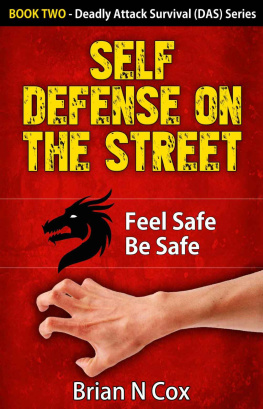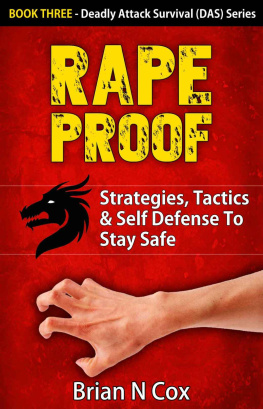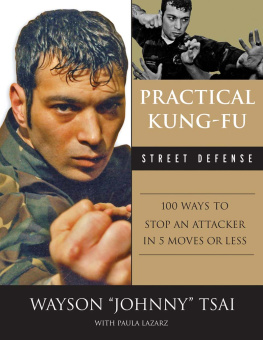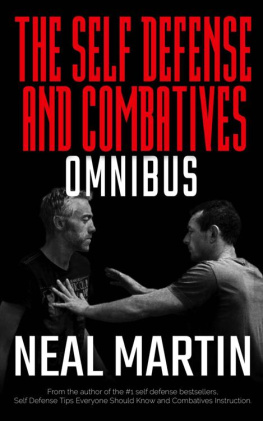SELF DEFENSE ON THE STREET
FEEL SAFE BE SAFE
BOOK TWO DEADLY ATTACK SURVIVAL (DAS) SERIES
By Brian N. Cox
Former federal law enforcement criminal investigator and intelligence officer,
martial arts and self-defence instructor
Protected by Copyright (2012) All Rights Reserved
Brian N. Cox is the author of The Chinese Woman spy-thriller series, available on the Amazon Kindle Store, Barnes & Noble (Nook) and Apple iTunes. Also books on criminal investigation, child safety and morego to: www.bcoxbooks.com
INTRODUCTION
If you have not read DAS Book One (Deadly Attack Survival), you should understand that DAS is not a martial art nor an art of self-defence. It is strictly a strategy to survive an attack by an assailant who intends to kill you or cause you grievous bodily harm, hopefully without suffering any injury yourself. Prior knowledge or training in a martial art is not necessary in order to learn DAS. However, there is no conflict with martial arts and DAS could be considered supplementary to a martial art. Besides lowering your risk of death, a great benefit of DAS is that it can be learned in a few days and you can train on your own without a partner.
TABLE OF CONTENTS
Unit One A Brief Overview of the Development of DAS
Unit Two The Law and Self-Defence
Unit Three DAS in a NutshellSimpleDirectEfficient
Unit Four Awareness of Potential Danger
Unit Five Developing Your Striking Technique
Unit Six Your Repertoire of Natural Weapons
Unit Seven The Street Attack
Unit Eight Targeting Your Assailants Knee Joint
Unit Nine Your Repertoire of Defensive Techniques
Unit Ten Defending Against Two Attackers
Unit Eleven Defenses Against Clubbing Weapons
Unit Twelve The Training Program
Unit Thirteen The Conclusion
About The Author:
Brian Cox is a former member of the Royal Canadian Mounted Police (RCMP) where he was employed in Major Crimes, Drug Law Enforcement and National Crime Intelligence (organized crime and terrorism). He was also an instructor in the Canadian Police College. After his retirement from the RCMP, he took employment as an Instructor at Northwest Law Enforcement Academy and eventually went to China to study Chinese police training and police self-defence systems. He remained living in China for five years.
Throughout his career in law enforcement, Cox had been a martial arts instructor, first in the art of karate and thereafter, in several styles of kung-fu (gongfu or wushu in Mandarin). He also instructed many self-defence courses to a variety of groups, including police and females. While living in China, he trained in gongfu and took particular interest in the category of martial arts known in China as the internal or soft arts. It was from these systems that DAS was developed.
Authors Note:
Although each book in the DAS series provides valuable information, each will be of much greater benefit if Book One, Self Defense: The Secret Chinese Strategy of Personal Power, is read first. I have repeated some of the information contained in Book One in the subsequent books not only as a refresher, but because understanding the contents of Book One are absolutely essential if you want to save your life when subjected to a potentially deadly attack. Another reason not to skip over information that appears to have been repeated from Book One is that most of the content has been expanded.
UNIT ONE
A BRIEF OVERVIEW OF THE DEVELOPMENT OF DAS
Originally, I was going to provide an indepth account of how and why Deadly Attack Survival was developed but those who edited the book thought it would only interest those few readers who study the history of martial arts in China. Therefore, the following is a very condensed overview of the development of DAS.
Most martial arts in China, usually called kung-fu in the west, but referred to as wushu or gongfu in China, take many years to master. Furthermore, they require superb physical conditioning and dedication to the training. Think of all the martial arts and combat systems you have encountered or viewed throughout your life; most have one thing in commonyou face your assailant in order to defend yourself from his attack. In China, these martial arts are usually found in the external methods/styles or hard methodsfitness, strength, speed and courage is a requirement as it is for almost all combat systems.
There are a few martial arts in China called soft methods or internal methods. One of the most popular soft method combat arts is taijiquan (tai chi chuan) or just taiji (tai chi) which is familiar to almost everyone in the west. In the USA and other western industrialized countries, this is taught as an exercise for middle age and old people, but traditionally in China, it is an art of combat.
Deadly Attack Survival follows the path of the three major internal martial arts in China, as follows:
XingyiThis is a direct, aggressive, attack-oriented form of gongfu. You do not allow your assailant time to think, react or protect himself. You strike his vital points immediately that you realize his intentions. This is the basis of DAS.
Taijiquan, commonly called just TaijiThe principle of this second form of gongfu, is to yield to strength and adhere to weakness, or more simply, yield to force and attack weakness. This the second, or intermediate phase of DAS.
Baguazhang, commonly called just BaguaThe principle of this third form of gongfu is to walk the circle; never remain in the target zone of your assailant; never stay on the line of attack. When he attacksyou are no longer there. Like Taiji, you avoid strength and force and attack weakness. Anyone who attacks you is leaving himself vulnerable to a counter-attack. The influence of Bagua is evident as in DAS defenses, you almost always get off the line of attack and remove yourself from your assailants target zone.
While living in China, I had the privilege of watching self-defence training in several police colleges. Most are similar to North America whereby the self-defence course is based on whatever martial art the instructor happens to be an expert. Self-defense for the police in China is more important than it is in the USA and Canada, for one basic reason; the police are generally totally unarmed during the course of their duties. They have no guns, no pepper spray, no Tasers and often even no batons. Even though China is a much less violent society than either the USA or Canada, it just takes one unfortunate incident during a police officers career to result in his/her death.
The real advantage to DAS, besides the fact that it actually works when attempting to survive a deadly attack, i.e., saving your own life, it can be learned just by reading the DAS book and can be usable within a couple of weeks, or even just a few days. Furthermore, you wont require further instruction (because it probably isnt available anyway) and you can train on your own without a partner while increasing your skill, week by week, month by month.
UNIT TWO
THE LAW AND SELF-DEFENSE
Deadly Attack Survival involves a very real risk of an intended victim applying deadly force in order to save his or her life. This is not something to be taken lightly and anyone training in DAS must be totally and completely aware of the law relating to self-defence and the application of force. You are not, of course, intending to cause death to your assailant but the risk of this happening is present.
The law in most jurisdictions is similar, the essence of which is. you may use as much force as necessary to defend yourself, but no more than is necessary . Therefore, each situation and each encounter may be assessed individually and the law applied quite differently. Also, the exact same circumstances may have different legal consequences, for example: A 120 lb woman is grabbed by the throat by a 190 lb. man; he raises his hand to punch her and says at the same time, I am going to beat you to death, and attempts to strike her as hard as he can. If the small woman is able to defend herself successfully and prevent the occurrence of her own death, and her 190 lb. assailant dies during the encounter, the woman would probably not be held legally liable in most jurisdictions; in fact, she may be viewed as a hero. If the exact same situation took place, but instead of a small 120 lb. woman, the intended victim was a 250 lb., armed, police self-defence instructor, or a 250 lb. mixed martial arts champion, and the 190 lb. attacker died during the encounter, the law would probably hold the larger man legally accountable. The courts would probably take the position that the 190 lb. assailant had no chance of successfully killing his intended victim (in the absence of a weapon), and further, that the intended victim was perfectly capable of defending himself without resorting to deadly force. In fact, the 190 lb. attacker, who was the author of his own fate, may be viewed as a complete fool, but also as a victim who was brutally beat to death by a bigger, stronger man.
Next page











